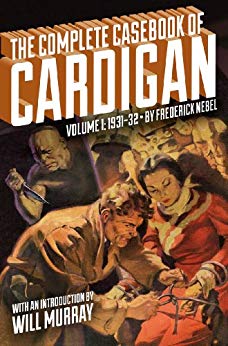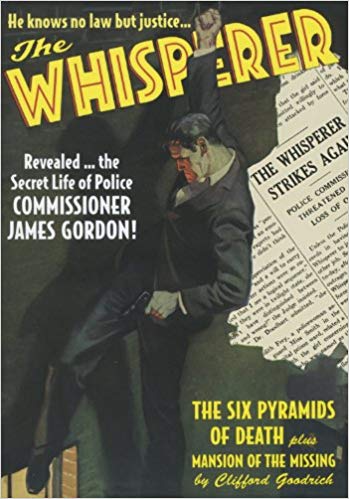 Black Mask alumni Frederick Nebel’s Jack Cardigan was one of the main reasons behind the success of the legendary Dime Detective Magazine. Cardigan first appeared in “Death Alley.”
Black Mask alumni Frederick Nebel’s Jack Cardigan was one of the main reasons behind the success of the legendary Dime Detective Magazine. Cardigan first appeared in “Death Alley.”
This is a tale for jazz and bourbon. Cardigan’s partner is dead–done in by drive-by–and the case is apparently closed. Only Cardigan believes otherwise. It doesn’t take long for Cardigan, P. I. to find trouble, both with the crooks and with the law. Said trouble sends the rest of his private detective office into the hospital. After all, St. Louis is a rough city–and a blissful change from New York or Chicago.
The familiar hand of Lester Dent’s Master Formula can be felt guiding events. Cardigan gets dropped into one peril after another, and not all he can fight his way out of. The murders of the detectives cross over with a spot of trouble that a newly widowed heiress finds herself in, drawn together into one final standoff, and a public gunfight.
“Death Alley” truly is a perfect four-chapter execution of Dent’s formula, awash in gin, whiskey, and tobacco smoke. Compared to the more adventurous Race Williams, Cardigan actually has to rely on some proper sleuthing–and an ability to ferret out connections as tenuous as smoke. It isn’t noir, Cardigan is never tempted and is instead vengeance personified as he searches for the killer, but you can see it from here.
There’s something about Black Mask writers that, even when riddled by slang now long out of date, their prose has a freshness to it that the 1930s hero pulps and 40s science fiction lack. Even when the hard-boiled stories are dated, they aren’t. Nebel is no exception. That’s not to say that I didn’t have to rely on a dictionary a click or so away for a couple terms. But in the end, with the required and satisfying twist, I want to see this done on the silver screen in proper black and white.
 Out of the foggy night steps a ghostly figure in gray — The Whisperer! His super-silenced automatics spitting blue flame, he hurls a hissing challenge to the Law and lawless alike! And hot on his crooked trail, legendary lawman Wildcat Gordon!
Out of the foggy night steps a ghostly figure in gray — The Whisperer! His super-silenced automatics spitting blue flame, he hurls a hissing challenge to the Law and lawless alike! And hot on his crooked trail, legendary lawman Wildcat Gordon!
In “The Six Pyramids of Death”, Commissioner James “Wildcat” Gordon starts sneaking around a countess’s house in the guise of The Whisperer, a vigilante in the same ominous mode as The Shadow. While searching for evidence that would convict the countess, The Whisperer gets mired in a net of bad luck–and frequent blows to the back of his head. For when he wakes up, he observes a secret meeting as cutthroats argue over six golden pyramids. But as the pyramids start disappearing, the cutthroats start dying. While The Whisperer is caught in a web of death, Commissioner Gordon must also fen off the machinations of his hostile mayor.
Billed as the most violent series Street & Smith ever published, The Whisperer wears its homage to The Shadow on its sleeve. Everything in that classic formula is present, from the ominous atmosphere to the brooding in the shadows, a radio-friendly calling card, and the twin automatics. Even the cadence of the story matches The Shadow, including the refrain of “For the man watching from the hiding place was The Whisperer.” Unfortunately, when assembling that classic formula, something broke along the way, as the sum is decidedly less than the parts.
Wildcat Gordon turns into The Whisperer through the addition of dental plates that build out his jaw. The catch is, they also affect his voice, reducing it to the whisper that gives his alter-ego his name. A novel solution to the quandary facing any vigilante trying to hide his identity–and one more convincing than the Moon Man’s–but it undermines the ominous mystery of The Whisperer with weakness. Worse still, The Whisperer gets knocked out on a regular basis in this story. While it gives Gordon personal stakes in bringing the criminals to justice–or a grave, for the murderers–With how many times someone has snuck up on and decked the Whisperer, it’s a wonder he still has a secret identity…or a life.
On top of that, the mood whiplash continues, replacing the dark, brooding ominous man of shadows with the folksy, good old boy commissioner. Knowing too much about the man behind the mask does undermine the story. Why not a folksy good old boy? Because, at least in fiction, most good old boys settle matters directly, without all the theatrics and sophistication a man of the shadows must use. But what is believable is the violence.
As for six pyramids of death, which have been an afterthought not just in this review, but in the story, a more classic example of a MacGuffin will be hard to find. There’s no mystery here, just a lure to get the gunmen shooting at each other, and the reason for their existence is a disappointing capstone to such a violent treasure hunt.
For writers, the prose of The Whisperer is an object lesson. As Lester Dent says, wave those tags. Not only does it give readers quirks that identify characters, but they also allow writers to use more than full names and pronouns to refer to their characters. This is especially helpful in action scenes, where the constant usage of a character’s full name brings The Whisperer’s fights too close to the dreaded checklist.
The sum total is that in “The Six Pyramids of Death”, The Whisperer misses the mark of the hero pulps. As such, he is more notable as being one of the many inspirations swept up into the plagiaristic Batman than for his own adventures.
Please give us your valuable comment